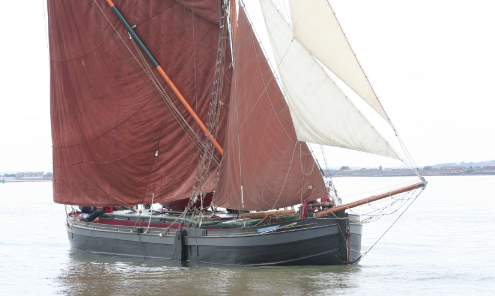Britain’s last sailing ship can be manoeuvred singlehanded without an engine, so why does she need one now?
An empty warehouse door slammed in the wind, slings swung solemnly from the hooks of abandoned cranes. Drifting lighters banged and rattled as they ranged, untended, across the dock. It was just a few days before Christmas and Tilbury Dock was deserted. I was alone as I manually shifted a 92ft, 79-ton spritsail sailing barge, half-laden with 150 ton of cattle feed from one end of the Tilbury Dock to the other.
All the stevedores had knocked off at lunch-time for their festive break leaving Cambria, the last vessel in northern Europe to trade under sail alone, down by the stern as they had only part loaded her with freight from a cargo ship. My skipper, Bob Roberts was laid out on the locker of the barge’s cabin, struck down by flu. We couldn’t leave the barge alongside the ship while we went off on our own Christmas holiday. She had to be moored securely at the top end of a side dock while left unattended.
As mate the task was down to me alone to move the barge into a safe berth. In between Cambria and that safe berth were nests of lighters, left to roam the docks at will as they had not been moored securely: the docks were considered a sort of industrial Venice by stevedores who used lighters, like free gondolas, to move from one quay to another to save walking the long way round. They rarely moored them up and these rogue steel boxes were left to gather on the leeward side of the docks.
On this occasion the leeward side was where Cambria had been loading freight. So by sculling the barge’s skiff to each lighter, making a line fast to the lighter’s bollards, then running it across to the dockside, I pulled and re-moored a dozen or so of these dumb barges. Then, once Cambria had a clear lead through the dock I sculled her dolly line, a light line on a small, thin windlass – a bit like a clothes mangle – which was bolted above the anchor windlass, to the nearest knuckle, as the corner of the docks were called.
Back aboard, I then wound in the dolly line and Cambria moved with ease to the knuckle, whereupon I took a turn before moving the dolly line further up the dock and repeated the process. In this manner I shifted the barge into her safe berth, moored up and called Bob up to go home for Christmas. I was very pleased with myself and expected him to be amazed at the distance I’d covered in the two or three hours I’d been at work, but he said nothing and shuffled off to catch the train home.This is what was expected of a mate of a sailing barge.
I write hoping that the members of the Cambria Trust will reconsider their plan to put an engine in the mulie-rigged spritty. She was built in 1906, traded until 1970 to all ports between the River Humber in Yorkshire to London, Southampton, Poole, Exeter and to harbours across Channel in France, all engineless, under her 5,000 square feet of canvas with two men and a cabin boy…and in later years not even with a cabin boy.
In 2007 she was awarded £990,000 from the Heritage Lottery Fund to be rebuilt because she had the distinction of being the last vessel flying the Red Ensign to trade under sail alone. At the time, the trust promised: ‘Cambria will be used for sail training and educational purposes, thus preserving the vessel and introducing her to a new audience who will be taught how she traded under sail alone – a supreme example of environmental transport which will also promote an understanding of new alternative technologies.’
Relying on the wind’s power is what draws us to sailing, nowhere more so than aboard the Cambria. If she is given an engine, won’t she lose the one thing that makes her unique?
Barge ahoy
Still sailing after all these years
Barge Match this weekend
End of the pier show
Dick Durham April 2016 podcast
The first thing I noticed, while leafing through the tourist board bumpf in the room of my Tallinn hotel, was…
Dick Durham May 2016 podcast
From my bedroom window I can see a small stone memorial in the corner of an ancient churchyard overlooking the…
Dick Durham September 2015 Podcast
Some sailors leave me feeling distinctly uncomfortable; they leave me with a sneaking suspicion that I haven’t sailed far enough,…
Dick Durham September 2016 podcast
He inhabits the shadows on our behalf, but as Dick Durham asks, has the night watchman also enjoyed a shady…







